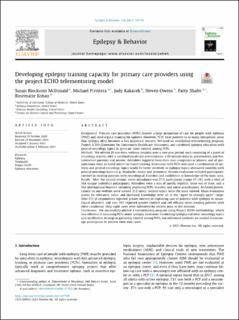| dc.identifier.citation | Susan Blocksom McDonald, Michael Privitera, Jody Kakacek, Steven Owens, Patty Shafer, Rosemarie Kobau. Developing epilepsy training capacity for primary care providers using the project ECHO telementoring model. Epilepsy & Behavior. Volume 116, 2021. | en_US |
| dc.description.abstract | Background
Primary care providers (PCPs) provide a large proportion of care for people with epilepsy (PWE) and need regular training for updates. However, PCPs treat patients in so many therapeutic areas that epilepsy often becomes a less important concern. We used an established telementoring program, Project ECHO (Extension for Community Healthcare Outcomes), and combined epilepsy education with general neurology topics to generate more interest among PCPs.
Methods
We offered 20 one-hour webinar sessions over a two-year period, each consisting of a panel of neurology experts, with a combination of case presentations, a 20-minute didactic presentation, and live, interactive question and answer. Attendees logged in from their own computers or phones, and all presentations were archived online for future viewing. Interviews with PCPs indicated a combination of epilepsy and general neurology topics would be better received, so epilepsy topics alternated monthly with general neurology topics (e.g., headache, stroke, and dementia). Session evaluation included participants’ comfort in treating patients with neurological disorders and confidence in knowledge of the topic area.
Results
After the second session, mean attendance was 27.5 participants (range 15–38), with a total of 164 unique individual participants. Attendees were a mix of mostly regional, some out of state, and a few international learners, including practicing PCPs, trainees, and nurse practitioners. Archived presentations on our website were viewed 212 times; seizure topics were the most viewed. Mean evaluation scores for relevance, value, and increased knowledge were all in the “agree to strongly agree” range. Over 97% of respondents reported greater interest in improving care of patients with epilepsy or neurological disorders, and over 98% reported greater comfort and self-efficacy when treating patients with these conditions. Only eight cases were submitted for review prior to the sessions.
Conclusions
We successfully piloted a telementoring program using Project ECHO methodology, which was effective in educating PCPs about epilepsy treatment. Combining epilepsy and other neurology topics was an effective strategy in garnering interest among PCPs, but additional methods are needed to encourage participants to present their own cases. | en_US |
